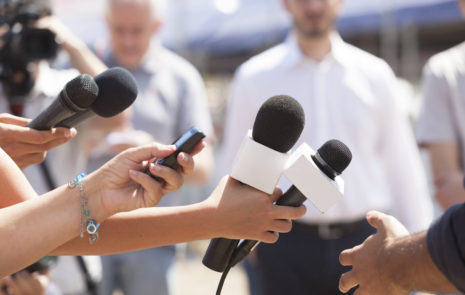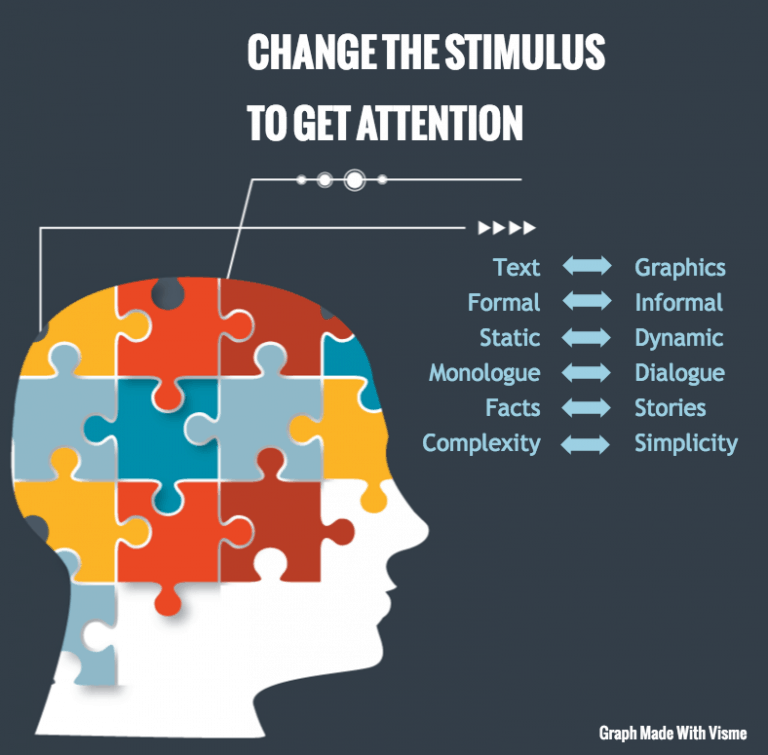
What content must do to hold audiences’ attention
It’s hard for content marketing to hold audiences’ attention. Estimates say 90% of the content that people consume is soon forgotten.
The real question is: “Do your customers remember the right 10%?” asks Dr. Carmen Simon, a neuroscientist and author of the book Impossible to Ignore.
“It is important and satisfying to control what people remember.” Neuroscience shows ways to help people:
- Pay attention to your content
- Sustain attention over time
- Remember the right 10% of your content.
What causes buyers to forget your content? Neuroscientists call the enemy inside your buyers’ brains habituation.
Human brains habituate quickly. For example, we ignore background noises such as music, road noise, airplanes, air conditioning and coworkers – until they’re called to our attention.
Do you hear these stimuli now, even though you didn’t notice them before? That shows you how powerful habituation can be.
New stimuli break through best when they’re novel. But even the most novel stimuli quickly become not-so-special.
In a world where people are bombarded with 1,500 to 30,000 messages a day, thanks to habituation, audiences have learned to tune out almost all of them. Habituation undercuts attention.
So how can we gain and hold audiences’ attention? Two factors influence habituation:
- Stimulus internal variation: How much do sensory stimuli change over time?
- Subjective arousal: How much do perceived novelty and familiarity vary from person to person?
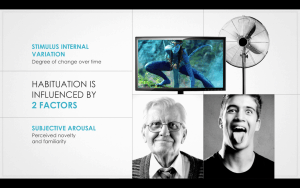
There’s nothing anyone can do about subjective arousal. But there’s much that we can control to vary the stimuli, evade habituation and hold audiences’ attention.
What Hollywood knows about content. Since the 1930s and 1940s, the average length of a shot in a movie has shrunk dramatically – from about 10 seconds to less than 4 seconds. At the same time, motion and movement increased significantly within the shorter shots.
Watching movies trains audiences to expect shorter shots, more cuts and more movement and motion. “It’s getting very difficult to keep people focused. It is getting brutal,” Dr. Simon notes.
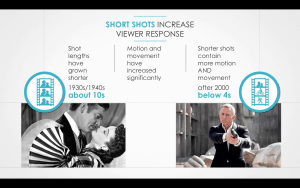
“The threshold for stimulation has changed. We have to work harder at varying the stimulus.” Dr. Simon advises marketers to think about it like this: “I’m asking, ‘Are you making it possible for your audiences to look away?’ How often do you provide a ‘cut’?”
To hold the audience’s attention, vary the stimulus frequently.
For maximum impact, vary the stimulus by going back and forth between two types of stimuli shown in the infographic at the top of this blog. The arrows point both ways to remind you to change the stimuli back and forth.
“Any time you change between any of these stimuli, you get the brain to refresh attention,” Dr. Simon notes.
“In order for a brain to appreciate any state on this list, it has to know the prior state. We wouldn’t appreciate simplicity unless we knew the complexity that it has come from.”
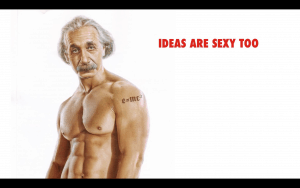
To hold audiences’ attention, keeping changing up the stimuli. Bring your audience surprises and changes they didn’t expect, instead of delivering what they expect and are becoming habituated to.
Keep your sights on what you want audiences to remember. “Use change to draw attention, but keep your metaphorical 10% constant,” Dr. Simon advises.
In other words, consistently reinforce one message again and again. Repeat your main message with variation, changing the stimuli you use.
Keep your main message consistent over time to add credibility. Your main message or home base is the 10% of your content that you want your audiences to retain.
Consistent messages can earn a place in your customers’ brains, specifically their “place cells.” What’s important is that, unlike short-term memory, place cells never run out of capacity.
Brains store consistent messages in place cells. Inconsistent messages never make it in there. That’s why learning the discipline to stay on message is crucial.
A 1-PageTM Message Map helps you stay on message by providing you an easy tool to help you remember one main message, your home base, supported by 3 or 4 positive points.
Vary the stimulus? Yes, frequently. Use all the tricks we marketers have up our sleeves.
Don’t be predictable!
Keep your main message consistent? Yes, always.
By understanding how to hold audiences’ attention, you can create content marketing that builds credibility, fosters relationships and turns prospects into customers.
Here’s a video of Dr. Carmen Simon on “The Neuroscience of Memorable Content.” She shares ideas on what marketers need to know about attention, memory and decision-making. It’s worth watching.
Related Posts
Presenting? Here’s how to handle tough audience questions
Have you noticed that fewer and fewer presentations leave time for audience Q&A? I’m not sure if this trend is due to conference organizer...
Why Content Marketing Needs A Revenue Quota
Tough times: the company’s revenues were down, and the marketing budget had shrunk. I knew we could produce revenue with content marketing, but I...
Create Message Maps by topic, not by audience
Imagine you’re driving from coast to coast. How many maps do you need? You want one map that shows you the whole journey, from...
Is your story ready to tell? 10-point message test
Is your customer, employee or investor message ready for launch? You’ve been slaving away for days, weeks or months to develop your company’s story....




